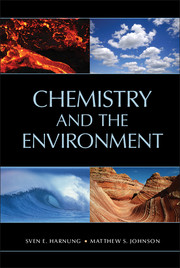Book contents
- Frontmatter
- Contents
- Preface
- Acknowledgments
- Chemistry and the Environment
- Introduction
- 1 The Earth
- 2 Environmental dynamics
- 3 The Spheres
- 4 Chemistry of the atmosphere
- 5 Chemistry of the hydrosphere
- 6 Chemistry of the pedosphere
- 7 Global cycles of the elements
- 8 The chemicals industry
- 9 Environmental impact of selected chemicals
- 10 The chemistry of climate change
- Appendix 1
- Appendix 2
- Appendix 3
- Appendix 4
- Appendix 5
- References
- Name index
- Subject index
- Miscellaneous Endmatter
Introduction
Published online by Cambridge University Press: 05 November 2012
- Frontmatter
- Contents
- Preface
- Acknowledgments
- Chemistry and the Environment
- Introduction
- 1 The Earth
- 2 Environmental dynamics
- 3 The Spheres
- 4 Chemistry of the atmosphere
- 5 Chemistry of the hydrosphere
- 6 Chemistry of the pedosphere
- 7 Global cycles of the elements
- 8 The chemicals industry
- 9 Environmental impact of selected chemicals
- 10 The chemistry of climate change
- Appendix 1
- Appendix 2
- Appendix 3
- Appendix 4
- Appendix 5
- References
- Name index
- Subject index
- Miscellaneous Endmatter
Summary
The environment is a fascinating subject for a chemist, with a seemingly endless variety of conditions combining dramatic changes in temperature, pressure, phase, and composition. It is also an extremely useful object of study from the practical viewpoints of economy and health. Environmental chemistry is the science in which the methods and results of chemistry are applied to processes involving chemical species in the environment.
Overview
More than 2,000 years ago in the Middle East, it was established that the Earth was a sphere, and the physical and chemical laws discovered since then allow the present description of the Earth as a physicochemical system. In a strictly chemical sense, the “elements” of the environment are the elements of the periodic table. However, it is convenient to add other kinds of structural units, for example, the spheres, which together with special branches of physics, for example, the laws of fluid dynamics, are needed to understand environmental systems.
Human activity
The agricultural and industrial revolutions (beginning around 1750) have allowed the human population to increase exponentially (Figure 1). In the recent past, the human population has been doubling about every 40 years, and 20 % of all humans born in the past 6,000 years are alive today. Population growth and advances in quality of life have been made possible by knowledge concerning how to use Earth’s resources. Specific examples include the production of fertilizer and cement, the invention of refrigeration, medical advances, and the invention and mass production of consumer goods ranging from clothes to personal electronic devices. A key challenge facing human society today is dealing with the consequences of our success.
- Type
- Chapter
- Information
- Chemistry and the Environment , pp. 1 - 3Publisher: Cambridge University PressPrint publication year: 2012



